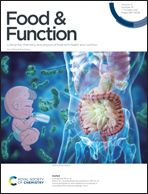The viability of complex coacervate encapsulated probiotics during simulated sequential gastrointestinal digestion affected by wall materials and drying methods†
Abstract
The objective of this study was to investigate the impact of protein type (sodium caseinate and pea protein isolate) and protein to sugar beet pectin mixing ratio (5 : 1 and 2 : 1) on complex coacervate formation, as well as the impact of the finishing technology (freeze-drying and spray-drying) for improving the viability of encapsulated Lactobacillus rhamnosus GG (LGG) in complex coacervates during simulated sequential gastrointestinal (GI) digestion. The physicochemical properties of LGG encapsulated microcapsules in liquid and powder form were evaluated. The state diagram and ζ-potential results indicated that pH 3.0 was the optimum pH for coacervate formation in the current systems. Confocal laser scanning microscopy (CLSM), viscoelastic analysis, and Fourier transform infrared spectroscopy (FTIR) confirmed that the gel-like network structure of the complex coacervates was successfully formed between the protein and SBP at pH 3.0 through electrostatic interaction. In terms of physiochemical properties and viability of LGG encapsulated in the microcapsule powder, the drying method played a crucial role on particle size, microstructure and death rate of encapsulated LGG during simulated sequential GI digestion compared to protein type and biopolymer mixing ratio. For example, the microstructure of spray-dried microcapsules exhibited smaller spherical particles with some cavities, whereas the larger particle size of freeze-dried samples showed a porous sponge network structure with larger particle sizes. As a result, spray-dried LGG microcapsules generally had a lower death rate during simulated sequential gastrointestinal digestion compared to their freeze-dried counterparts. Among all samples, spray-dried PPI–SBP microcapsules demonstrated superior performance against cell loss and maintained more than 7.5 log CFU per g viable cells after digestion.



 Please wait while we load your content...
Please wait while we load your content...